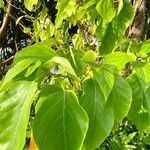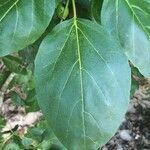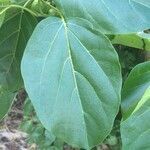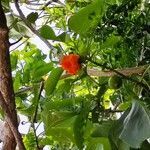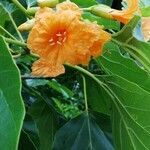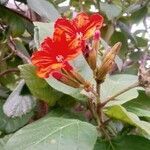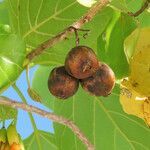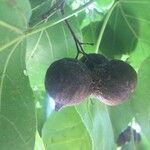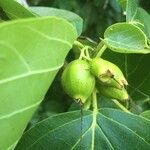Tree, 2-15 m high. Branches grey to light brown, wood orange. Leaves with a 2-8 cm long petiole; blade ovate to elliptic, 8-20 by 5-15 cm, entire or rarely with few teeth, base obtuse to rounded, rarely subcordate, apex obtuse to rounded, rarely acute and shortly acuminate, with 4-5(-6) primary nerves on each side, upper surface slightly nitidulous, with very short, appressed hairs, sometimes with small groups of mineralized cells at base of hairs, lower surface velutinous or even tomentose along median and primary nerves. Inflorescence terminal, composed of 6-20 flowers, with a short peduncle. Calyx cylindrical, 10-20 mm long, 4-8 mm wide, glabrous or with few short, rigid hairs, with 3 short, triangular lobes, persistent, strongly accrescent and envelopping the fruit. Corolla 3.5-5 cm long and wide, orange, the lobes 5-7, large, rounded-truncate. Stamens: filaments inserted above middle and at base of limb of corolla, exserted. Fruit obovoid to subglobose, 20-30 mm long, 15-25 mm in diam.
Tree or shrub to 15 m high, seldom upright; trunk dividing near base; branches sprawling; bark fissured. Leaves: lamina broadly ovate, 4–19 cm long, 2.5–16 cm wide, obtuse and sometimes asymmetrical at base, entire to crenulate margin, obtuse to shortly acuminate at apex, shiny green above, subglabrous except abaxial venation, with hairy domatia; petiole 1.3–10 cm long. Panicles terminal, dichotomously branched; flowers probably heterostylous. Calyx c. 11–16 mm long, sparsely hairy to glabrous outside, pubescent inside; lobes c. 2 mm long. Corolla funnel-shaped, pubescent outside, golden-yellow or orange, fading to pinkish orange; tube (1.7–) 2.5–3 cm long; lobes 1–2.5 cm long, crumpled in bud. Stamens included to just exserted; filaments inserted in upper half of corolla tube, 3–8 mm long. Fruit ovoid to ellipsoid (to ± globular), enclosed by hardened, enlarged calyx, c. 2–3 cm long, 1.5–2.8 mm wide, green to brown or blackish, 1-or 2-seeded.
A spreading shrub or tree, 2-15 m high. It spreads to 3-10 m across. The stem is erect and the bark is grey and slightly rough. It has cracks along its length. The leaves are broad and oval. They are 8-20 cm long and 5-15 cm wide. Sometimes they have 2 lobes near the base, making the leaf heart-shaped. On the lower surface of the leaf, there are fine hairs near the veins. The leaves are glossy green on top and paler underneath. The leaf stalks are long (3-5 cm). The flowers are orange. They form a tube 3.5-5 cm long and with 5-7 broad lobes which spread to 3-4 cm across. The flower heads are made up of 6-20 flowers, and they occur at the ends of branches. The fruit is 2-3 cm long, by 1.5-2.5 cm across. It is green or yellow. It hangs down and turns brown when ripe. There is a single seed inside, and it is 2-3 cm long. The fruit has a beak at the tip and an apple like texture, but fairly hard.
Trees to ca. 3 m tall; bark yellow-brown; branchlets glabrous. Petiole 3-6 cm, glabrous; leaf blade ovate to narrowly ovate, 8-18 × 6-13 cm, abaxially densely cottony in vein axils, adaxially ± spotted, base obtuse to rounded, rarely cordate, margin entire to subundulate, apex acuminate to acute. Cymes opposite leaves, ca. 12 cm wide at anthesis. Pedicel 3-6 mm. Calyx cylindric, ca. 13 × 8 mm, leathery; lobes irregular, short. Corolla orange, funnelform, 3.4-4.5 cm; throat ca. 4 cm wide; lobes divaricate, orbicular. Drupes ovoid or obovoid, ca. 2.5 cm, with corky mesocarp, enclosed by enlarged persistent calyx. Fl. Jun.
Leaves alternate; petiole 2.5–7.0 cm. long, subglabrous; lamina 6–20 x 5–16 cm., ovate or widely ovate to circular, glabrous or with some minute appressed not bulbous-based hairs, older ones frequently dotted with groups of cystoliths above, more or less pubescent along the midrib and some secondary nerves and usually minutely tomentose in the axils of the principal secondary and tertiary nerves below, obtuse to rounded and often shortly acuminate at apex, obtuse to truncate, rarely subcordate at the base, with entire or slightly repand margins, papyraceous, with 6 pairs of secondary nerves.
Ovary c. 3 mm. long, conical, glabrous; style in the short-styled flowers c. 22 mm. long, first-branched at c. 17 mm. and with stigmatic branches c. 1.5 mm. long, in the long-styled flowers c. 30 mm. long, first-branched at 21–23 mm. and with stigmatic branches 2.5–3.0 mm. long, flattened.
Calyx 12–15 mm. long and 4–5 mm. in diam. at the mouth, cylindric or slightly conical, coriaceous, usually with 3–5 rounded teeth up to 4 mm. long, glabrous or very sparsely strigose outside and inside but densely strigose inside on the teeth.
Stamens inserted at c. 20 mm. from the base of the corolla tube; filaments in the short-styled flowers c. 8 mm. long, in the long-styled flowers 3–5 mm. long, glabrous; anthers 2.5–3.5 mm. long.
Fruit a nut, c. 25 x 22 mm., subglobose, smooth, shining, completely enclosed in the enlarged urceolate calyx; mesocarp suberose; pyrene angular, much ridged and scabrous, containing 1–2 seeds.
Corolla 30–45 mm. long, infundibuliform, orange, glabrous or nearly so; limb nearly as broad as the length of the corolla; lobes 5–7, broad, rounded, sometimes with crenate margin, spreading.
Shrub up to 4 m. high (or a tree up to 15 m. high outside the Flora Zambesiaca area); branches angular when young, glabrous or subglabrous.
Inflorescence cymose, loosely branched, short, 6–20-flowered, terminal, often apparently opposite-leaved.
Flowers hermaphrodite, heterostylous, on pedicels 2–8 mm. long joined near the apex.

